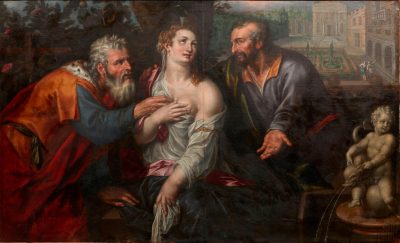The first ever exhibition devoted to artistic representations of the biblical figure Susanna explores a narrative and pictorial tradition which resonates particularly with the #MeToo movement. Public debates about the abuse of power, sexual coercion and violence have focused largely on the film industry. It passed unnoticed that this subject has been explored in older artistic media (primarily painting and the graphic arts) under the title ‘Susanna and the Elders’ for centuries: The pictorial motif from the Old Testament depicts sexual harassment and coercion in an exemplary way. The Book of Daniel recounts the story of Susanna and the cruel methods used to coerce her: enchanted by her beauty and driven by lust, two judges try to blackmail a young married woman into having sex. Susanna refuses and is slandered by them. The Prophet Daniel questions the men separately and thereby reveals their lies. Susanna is saved; the Elders are sentenced to death, the penalty they had planned for their victim. The proximity between the perpetrators and their victim, as well as the evident imbalance of power is still a common pattern today. The legal proceedings and criminal investigation also echo recent events.
Susanna explores the subject at the highest artistic level through paintings, book illuminations, drawings, etchings and crafts. Representations of Susanna from the Middle Ages to the present are brought into dialogue, raising questions about their narrative techniques and interpretation of the subject. They are analyzed in the light of historical and current gender roles, as well as religious, political and social ideas or even stereotypes. The complex subject is approached in terms of voyeurism (Susanna bathing), coercion and physical violence (Susanna and the elders), as well as slander (Susanna on trial), with the focus shifting according to the period and artistic landscape. By bringing them together, the exhibition traces how the Susanna motif has informed and been shaped by different stylistic preferences, the changing demands of the art market, as well as competition and artistic discourse.
Loans will include works by Jan Massys (Phoebus Collection, Antwerp), Joachim Wtewael, Hendrik Goltzius, Cornelis van Haarlem (Alte Pinakothek, Munich), Hendrick de Clerck, Anthony van Dyck (Alte Pinakothek, Munich), Jacob Jordaens (Statens Museum for Kunst, Copenhagen) Massimo Stanzione, Francesco Trevisani, Sebastiano Ricci, Johann Zoffany, Eugène Delacroix, Édouard Manet, Jean- Jacques Henner, Lovis Corinth and Franz von Stuck. Another outstanding work comes from the Wallraf Museum’s own collection. It is a hitherto nearly unknown painting by Dutch Baroque painter Nicolaas Roosendael, depicting Susanna on trial.
The exhibition is curated by Dr. Anja K. Sevcik, Head of the Baroque Departement, and Dr. Roland Krischel, Head of Department of Medieval Painting, who recently organized the Wallraf’s monographic exhibitions on Rembrandt (2019) and Tintoretto (2017). Renowned specialists in the field, including Christina Leisering, Elizabeth Cohen and Mithu Sanyal are contributing to the catalogue.

Phoebus Foundation, Antwerp.
[text via Codart.nl]